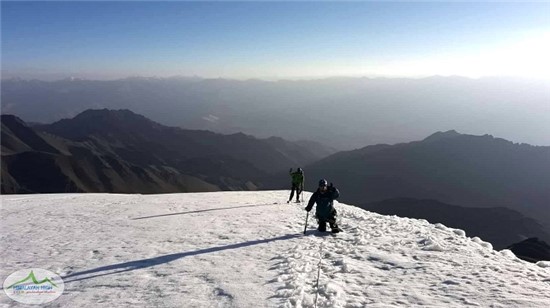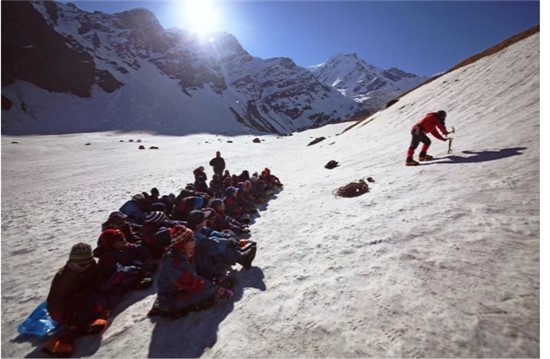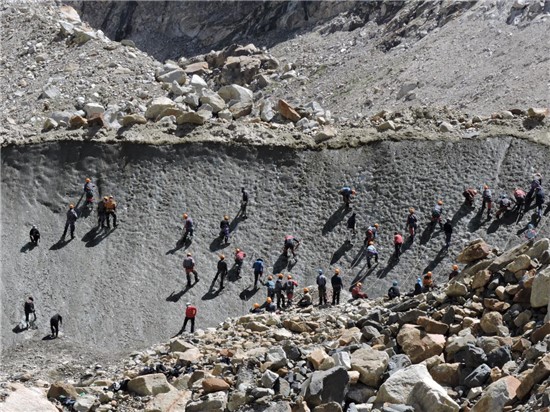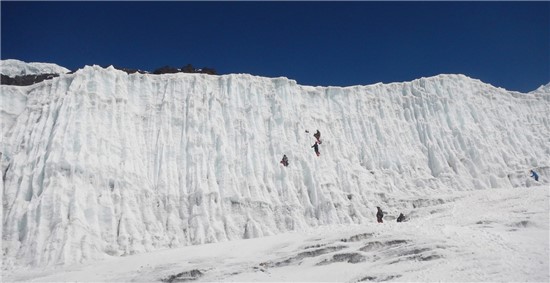Mountaineering Training in India - A Bigger Picture

The Geography of India is very diverse and has everything from ocean to mountains, desert to forests and villages to urban landscapes. India is blessed to have the mighty Himalayas standing on its entire northern and north eastern borders. This same fact undoubtedly makes India one of the best places in the world to learn and practice the sport of mountaineering. Mountaineering involves real dangers and sometimes climbers have to face life or death situations on the mountains. But this does not mean that there is no way to deal with those risks. That's why the sport of mountaineering is so fascinating and that's where the mountaineering training comes in. If you receive good training first, then practice and enhance your skills and consider safety as paramount in every situation, you'll always remain safe on any mountain and you'll be confident while climbing.
India is really one of the leaders in the field of mountaineering and Indians have always been fascinated by the Himalayas. That's why the first mountaineering training institute in India was opened in 1954, just one year after the first ever successful summit climb of Mt. Everest by Sir Edmund Hillary and Sherpa Tenzing Norgay. Almost all of the mountaineering training institutes in India are quite good with very experienced instructors and overall good facilities.
So, if you are looking to start your mountaineering journey by doing a basic training course, look no further. There is no place better than India and the Himalayas to learn the nuances of climbing a mountain.
Available Training Courses
As the title of our article suggests, we are going to discuss the options of doing a Basic mountaineering course and Advanced mountaineering course in India in detail. But the article is a bit more comprehensive to help those who have little to no knowledge of mountaineering training. So let us tell you briefly about all the training courses in mountaineering that are available in any institute.
- Basic Mountaineering Course: This is the first training course to be done to start mountaineering. This does not have any pre-requisite or any required experience to attend this training. But for all the institutes, generally the age of a trainee should be 18-40 years. A good level of physical fitness is also required to successfully complete Basic training or any other training course of mountaineering. BMC involves a lot of class room training and field training as well. This introduces a trainee to almost all the basic concepts of climbing, working with a rope and climbing equipment etc. Rock climbing, ice climbing, glacier walk, altitude gain, rescue, first aid and mountain medicine will all be a part of this training. Course duration is generally 28 days and there are few small exams at the end of the course to evaluate the trainees and they are given certificates with grades.
- Advanced Mountaineering Course: Advanced Mountaineering Course (AMC) can be done only after obtaining an 'A' grade in BMC. As name suggests, this course teaches you more advanced and practical ways of climbing. This again includes everything from rope work, equipment, rock craft, ice craft, negotiating boulders and crevasses, advanced techniques like ladder launching and multiple ways of rope fixing, expedition planning, navigation and rescue etc. This training course brings you much closer to the real world climbing and expedition planning. In some institutes, there is even an actual expedition of considerable difficulty as a part of training which trainees have to plan and execute under the supervision of their instructors. This is a really good training if you want to consider doing serious mountaineering expeditions in future. The duration of this training is again generally 28 days and age limit is also same as 18-40 years.
- Search and Rescue Course: Search and Rescue Course is mostly intended for already active mountaineers who participate in or lead serious climbing expeditions. This can be done only after obtaining an 'A' grade in AMC and it is good to have some climbing experience before attending this course. Not all the mountaineering institutes conduct SNR course. Rather than climbing, this training course focuses on the techniques of navigation, search and rescue in the mountains. The course has many practical drills mimicking real life situations where you need to search and rescue lost climbers or injured members of a climbing team. Emergency response and mountain medicine is a big part of this training. Trainees also learn how to rescue and bring back injured climbers over varying terrain and with different number of rescuers available. There are many interesting elements involved like river crossing, map reading, GPS navigation, navigation at night etc. The duration of this training is generally 21 days.
- Methods of Instruction: This training course can also be done after obtaining an 'A' grade in AMC. As name suggests, this takes you on a path of becoming an instructor to others. So it is intended to teach the methods of instruction to mountaineers if they are interested in becoming an instructor in the field of mountaineering. This has good amount of classroom training and field training which gives you the knowledge and some experience to teach others. Duration of this course is also generally 21 days.
Mountaineering Institutes in India
Having talked about the available training courses, we'll now focus on the next most important thing, the institutes. So here is a list of major institutes conducting mountaineering training courses in India.
- Nehru Institute of Mountaineering (NIM), Uttarkashi, Uttarakhand.
- Himalayan Mountaineering Institute (HMI), Darjeeling, West Bengal.
- Atal Bihari Vajpayee Institute of Mountaineering and Allied Sports (ABVIMAS), Manali, Himachal Pradesh.
- Jawahar Institute of Mountaineering & Winter Sports (JIM & WS), Pahalgam, Jammu & Kashmir.
- National Institute of Mountaineering and Allied Sports (NIMAS), Dirang, Arunachal Pradesh.
- Indian Himalayan Centre for Adventure & Ecotourism (IHCAE), Chemchey, Sikkim
Please note that this list of institutes is not in any particular order. This is also not a complete list of all the mountaineering institutes in India. These are the major and well known institutes. Apart from these, there are several other institutes as well like Indian Institute of Skiing and Mountaineering in Gulmarg, Jammu & Kashmir. But it was not included in the list above as it is better known for its skiing training.
Brief Details About Mountaineering Institutes
- NIM, Uttarkashi: NIM is one of the most prestigious mountaineering institutes in India. Established in 1964, it offers all the 4 training courses. It has one of the best training facilities, equipment and instructors too. Many instructors here are mountaineering veterans having decades of experience in the mountains. NIM is the only mountaineering institute in India certified by the international federation for climbing and mountaineering - UIAA. True to its motto "Success lies in courage", NIM really gives the best possible training to aspiring mountaineers and teaches them to be courageous and skilled in the mountains. The level of technical skills taught, the quality of training equipment and the instructors here are undoubtedly one of the best. NIM is also known for maintaining highest standards of discipline. The rock climbing training happens at Tekhla rock climbing area near the institute and most of the field training happens in the Dokriani Bamak glacier area. Because of its reputation, NIM is also a highly sought after institute and it can have fairly long waiting periods to join any course.
NIM website: https://www.nimindia.net/

Picture Courtesy: NIM Website
- HMI, Darjeeling: Established in 1954, HMI is the oldest mountaineering institute in India. It is also one of the best. Some of the best known mountaineers in India have been a part of HMI and have also taught students here in the past. These legendary mountaineers include the stalwarts like Sherpa Tenzing Norgay, the first person to climb Mt. Everest successfully in 1953 who became the first Director of field training at HMI and Sherpa Nawang Gombu, the first person in the world to climb Mt. Everest twice who also became the Director of field training at HMI later. HMI has a really glorious and rich history of promoting mountaineering in India. The instructors here today also carry loads of climbing experience with them and it is a real opportunity to learn from them. HMI is also known for its discipline and a brutal training regime, specially for basic mountaineering course. The trek to HMI base camp is considered the toughest among all training institutes. In last 4-5 years, HMI has upgraded a lot of their training equipment and the infrastructure at the institute has also been improved. Just like NIM, for HMI too there is generally a long waiting period before joining any course. HMI conducts all of their classroom training and rock climbing training at the beautiful institute campus in Darjeeling with the views of mighty Kanchenjunga looming large. All field training happens in West Sikkim at the Chowrikhang base camp, Rathong glacier and the Kabru massif area.
HMI website: https://hmidarjeeling.com/

Picture Courtesy: HMI Website
- ABVIMAS, Manali: ABVIMAS is also a well known institute in Manali, Himachal Pradesh. It is not only present in Manali but it has total 9 sub centers across the state of Himachal Pradesh. Thus, it is the largest mountaineering institute in the country and has trained more than 40,000 students so far. Most of the instructors here are experienced and come from an Army background. Along with mountaineering, this institute teaches skiing and paragliding too to students. Available mountaineering courses here are BMC, AMC and Methods of Instruction course.
ABVIMAS website: https://www.adventurehimalaya.org/

Picture Courtesy: ABVIMAS website
- JIM & WS, Pahalgam: JIM & WS was established in 1983 at Pahalgam in Jammu & Kashmir. This institute offers training in mountaineering and skiing and all 4 mountaineering courses are available here. The institute is run from 3 different centers. Like almost every mountaineering institute in India, JIM & WS also comes under the central ministry of defence and all the instructors here come from the 3 branches of Indian armed forces and mainly from Indian Army. So you should definitely expect the highest level of discipline and dedication.
JIM & WS website: https://www.jawaharinstitutepahalgam.com/

Picture Courtesy: JIM & WS Website
- NIMAS, Dirang: NIMAS at Dirang, Arunachal Pradesh is the newest mountaineering training institute in India and it is the one creating maximum buzz right now. It is a unique institute offering training to students in Land, Water and air based adventure sports activities. It has brought many adventure sports on the same platform. It was established in the year 2013. Like other institutes, most of the instructors here are from the elite regiments of Indian Army. In mountaineering training, the ice climbing wall at Meerathang glacier is considered one of the best for students to learn ice wall climbing techniques. NIMAS offers all 4 mountaineering training courses to students. NIMAS is definitely worth a visit for every adventure enthusiast.
NIMAS website: https://nimasdirang.com/

Picture Courtesy: NIMAS website
- IHCAE, Chemchey: Established in 2009, this is also a new institute offering mountaineering training courses. IHCAE has been made in a small but pristine village of Chemchey in Sikkim. The Singalila range here offers excellent opportunities of climbing and this is a very beautiful and relatively unexplored area.
IHCAE website: https://www.ihcaesikkim.org/
How to select a good mountaineering institute?
Now this is the core of the topic we are discussing here. As we have already said, all the training institutes are quite good but there are still few small factors which differentiate all institutes with each other. These factors are...
- Waiting period to join a course: Higher waiting period indicates high demand and high quality of training. But if your personal situation doesn't allow you to wait much before joining a course, you've to consider the institute with less waiting period or no waiting period and this factor becomes most important for you.
- Quality of training equipment and infrastructure: Quality of equipment and training infrastructure both at the institute and in the field is very important and it is not very different in all the institutes. These things are good everywhere because climbing equipment is directly related to your safety. NIM is known for its safety standards. As pointed out earlier, HMI has also modernized much of its equipment and NIMAS is a totally new institute with good quality equipment and infrastructure. So these 3 stand out from the rest. Next, you can consider ABVIMAS as it is also quite good.
- Quality and experience of instructors: This is a factor which is almost same everywhere. Most of the instructors in all the institutes are from Indian Army. Many times, they are trained from High Altitude Warfare School of the Army. So they are very well trained mountaineers, strong athletes and they carry experience of climbing many big mountains and participating in expeditions. Some civilian instructors are also there who are often even more experienced. So instructors are fortunately good in every institute.
- Structure and type of training: This is the last and an important factor which differentiates the institutes. The technical part of the training is best at NIM. The method of teaching and the techniques of climbing at NIM are unmatched. NIM teaches students not just one technique but all possible ways of doing a particular climb or rappel for example. NIM takes AMC students to summit a peak as part of expedition planning during the course. This peak is usually Draupadi Ka Danda 2 (DKD2). This adds to valuable experience of students. The trek to NIM base camp is considered relatively easy. But waiting period for BMC and AMC is also usually longest.
On the other hand, HMI has really good training facilities at the institute campus and also the rock climbing area. Trek from Yuksom to Chowrikhang base camp in West Sikkim is probably the hardest base camp trek in all the institutes. But this is an advantage for the students because it also prepares them for big expeditions where participants need to ferry good amount of load for many days in the mountains. BMC course at HMI definitely makes students tough physically and mentally. In AMC, HMI usually doesn't take students for a summit climb but they take them for altitude gain on the Kabru Dome peak. Glacier and ice climbing training happens on Rathong glacier and Kabru glacier which provide good training areas. Waiting period for BMC and AMC is usually quite long at HMI too.
Next are NIMAS and ABVIMAS. Both these institutes also offer fairly good infrastructure for training with experienced instructors. At these institutes too, all the important technical aspects of training are definitely covered and the structure of training is more or less same as other institutes. So these are worth considering for BMC and AMC. Waiting periods at these two institutes can be much lesser compared to NIM and HMI.
Which course is better where and why?
The sport of mountaineering is not only about following techniques or only brute physical strength. A successful mountaineer needs a good mix of many different skills. A good mountaineer would need carefully practiced and developed climbing skills, the physical capabilities of a professional athlete and a sharp brain to take right decisions in the most difficult and inhospitable situations to take care of self and others. All this makes a good climber. So ideally, to acquire all the skills, we suggest one to have different experiences in the training too.
As discussed, NIM and HMI are two top mountaineering institutes in India without a doubt. If a complete beginner goes to HMI, it will feel like a little brutal place honestly. Sometimes, one might think that the training is too hard. But trust me on this, this training experience at HMI will give you a good glimpse of what mountaineering is really about. HMI will teach you discipline in the mountains. It will teach you that climbing mountains is not easy, it is supposed to be difficult. It will bring you in the right mindset by combining technical training with tough physical challenges. You will become physically and mentally tougher. All the days will have a packed schedule and training will be intense. So this HMI experience must not be missed by any aspiring mountaineer and we recommend everyone to do their basic course (BMC) from HMI.
When it comes to AMC, we recommend to do this from NIM. Because as already said, NIM is the best institute in the technical aspect of the training. The importance of technical skills in safe climbing is obviously huge. So after doing a basic course, when you've understood the sport of mountaineering at a basic level and you decide to go for the advanced training, you must experience it at NIM. Training at NIM will thus make you a complete and sufficiently trained mountaineer. You'll have a good experience of the technical training and physical part. You'll train with many different instructors at different glaciers and regions. And doing AMC from NIM will give you an opportunity to plan an expedition and climb to the summit of DKD2 during the course itself. Then you'll be hopefully ready to join real expeditions in the Himalayas. After this training, the rest will be up to you. More practice and experience will make you a better climber.
Our Final Opinion
Although, we have said this several times that all mountaineering institutes in India listed here are quite good. They all operate under the ministry of defence. They have really good and experienced instructors and training courses are well structured. But if we must list them in an order of preference, it will be like this:
1. NIM 2. HMI 3. NIMAS 4. ABVIMAS 5. JIM & WS 6. IHCAE
The most preferred way would be to do the BMC course from HMI and AMC from NIM. So you must plan and target to do your training like this. If due to any reason like waiting period or something else, you can't follow this approach. Then you can definitely do one of the courses from NIMAS or ABVIMAS too. They are also almost as good as NIM or HMI. In this case, you should try to do your second course from NIM or HMI, preferably AMC from NIM.
Apart from this, pay attention to your physical fitness before going for any mountaineering training. It will help you a long way in finishing your training successfully and achieve your best. Good Luck !
